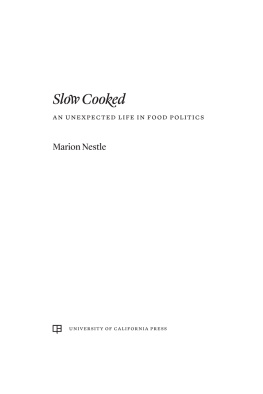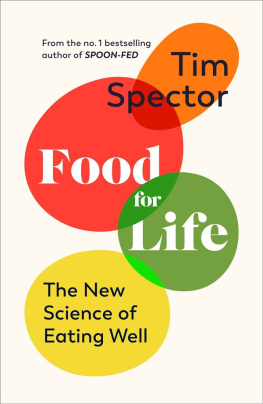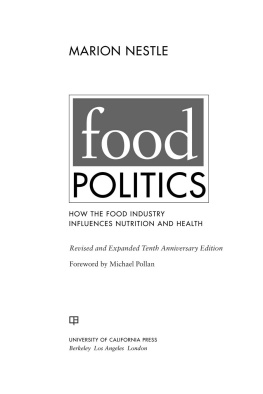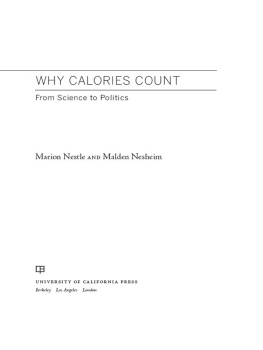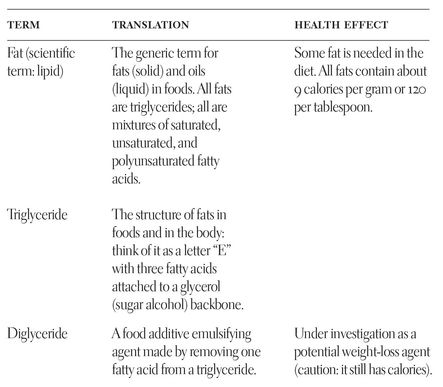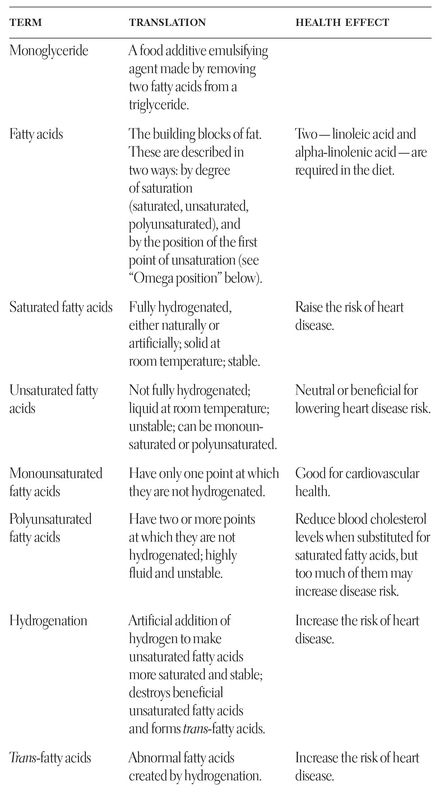I suppose it is possible to write a book as a work of solitary pain or pleasure, but I do not work that way. Friends, family, and colleaguessome near and some far away, some known to me personally and some notparticipated in this project to one degree or another.
The book began as a result of conversations with Alix Kates Shulman and Ann Snitow. Later advice from Gary Lefer, Malden Nesheim, Michael Pollan, and Laura Shapiro helped shape its approach. I was inspired throughout by the work of Joan Gussow, Michael Jacobson and his colleagues at the Center for Science in the Public Interest, Marian Burros at The New York Times, and the anonymous writers and researchers at Consumer Reports. Whenever I thought I was really onto something, I checked my files and inevitably discovered that they had been there first, and years ago. My cousin Ted Zittell provided an exceptionally thoughtful and much needed tutorial on how supermarkets work.
Many experts in one or another aspect of agriculture, retailing, food, nutrition, food service, and food consumptionworking for trade associations, professional associations, universities, trade publications, food companies, restaurants, government agencies, or on their owngenerously provided articles, documents, advice, suggestions, or information about one or another topic in this book: Terri Altamura, Dan Barber, Andr Bensadoun, Mark Berlind, Haven Bourke, Stacey Brown, Steve Clapp, Joe Corby, Stephanie Crane, Joanne Csete, Patty Debenham, Gayle Delaney, Katherine DiMatteo, Lisa Duchene, Fred Ehlert, John Fagan, Christian Fitchett, George Flowers, Alan Golds, Vivian Gornick, Barbara Haumann, Howard Johnson, Dick Jones, Robert Kaufelt, Deborah Krasner,Chris Krese, Edmund LaMacchia, Gary Henry Lovejoy, Max Mayeaux, Jim McLauglin, Ed McLoughlin, Mardi Mellon, Greg Miller, T. Clint Nesbitt, Bill Nesheim, Andrew M. Novakovic, Susan Okie, Brendon ONeil, Elizabeth Pivonka, Robert M. Reeves, Joshua Reichert, Kathleen Reidy, Thomas Ressler, Jessica Richardson, Fiona Robinson, Maury Rubin, Susan Schiffman, Stephen Simkins, Elaine Smith, Elaine Speer, Bill Springer, Tom Stenzel, Tom Strumulo, Paul Thacker, Andy Vestal, and Jason Young. I apologize to anyone inadvertently left off this list.
Walter Lynn (Cornell University, Bolton Point Water Plant), Matthew Reich (Tom Cat Bakery), Jim Munson and Stephen Schulman (Dallis Coffee), and Steve Michaelson (FreshDirect) took me on tours of their facilities, and Marvin Taylor was my host on a trip to his local New Jersey Costco. Bill Feldman made it possible for me to subscribe to Food Chemical News. Margaret Wittenberg and her colleagues Kate Lowery and Fred Shank at Whole Foods provided contacts for information and a photography location. Peter Menzel and Faith DAluisio took the jacket portrait.
Joyce Goldstein, Evan Goldstein, and Barbara Piro provided a West Coast haven for writing. My children and their partnersCharles Nestle and Lidia Lustig, Rebecca Nestle and Michael Suenkelparticipated in the research and much else. Elinor Blake, Ellen Fried, Kyle Shadix, Marcia Thomas, Fred Tripp, and Lisa Young kept me up-to-date on current events. Amy Bentley, Mark Furstenberg, Betty Fussell, Rebecca Goldburg, and Nancy Simkins read and commented on early drafts of chapters or sections, and Gabrielle Langholtz, Lauren Lindstrom, and Rebecca Nestle did the same with the galleys.
At New York University, Lisa Kroin, Kelli Ranieri, and Liz Young provided life support, Sheldon Watts kept my computers in working order and virus-free, and Lauren Lindstrom provided expert research assistance. I am especially grateful to my colleagues in the Department of Nutrition, Food Studies, and Public Health, to dean Mary Brabeck, and to provost David McLaughlin, for their generous support of my work.
Loma Flowers, Malden Nesheim, Lisa Sasson, and my agent, Lydia Wills, read and commented on the entire manuscript at one or another stage of preparationsometimes multiple stagesand I can never thank them enough for their advice, comfort, and encouragement during its more challenging moments. Finally, it is a pleasure to acknowledge the extraordinarily skilled work of the staff of Farrar, Straus and Giroux: in particular Kevin Doughten, Karla Eoff, Elizabeth Schraft, Jeff Seroy, and my editor, Paul Elie.
Web addresses were active when this book went to press in January 2007. To ease access to URLs, these notes are posted at www.whattoeatbook.com and www.foodpolitics.com .
INTRODUCTION
I wrote about the health consequences The University of California Press published the books (2002 and 2003) and issued them in paperbound editions (2003 and 2004). For the reactions to them, pro and con, see www.foodpolitics.com .
As the social theorist Mr. Schwartzs thesis: when you have too many choices, freedom of choice becomes a tyranny of choice. The book was published by HarperCollins in 2004; the quotation is from page 2.
This conflict begins U.S. Department of Health and Human Services and U.S. Department of Agriculture, Dietary Guidelines for Americans, 2005, 6th edition (Washington, D.C.: U.S. Government Printing Office, January 2005), available at www.healthierus.gov/dietaryguidelines . The pyramid, issued in April 2005, is at www.mypyramid.gov .
Listen to this 1959 advice This came in a cookbook aimed at heart disease prevention by Ancel and Margaret Keys, Eat Well and Stay Well (Doubleday, 1959).
Nutrition arguments are David R. Jacobs Jr. and Lyn M. Steffen discuss the reasons why reductive approaches to nutrition are insufficient in Nutrients, Foods, and Dietary Patterns as Exposures in Research: A Framework for Food Synergy, American Journal of Clinical Nutrition 78 (Supplement 2003): 508S13S. The health benefits of foods are greater than the benefits of their single components.



